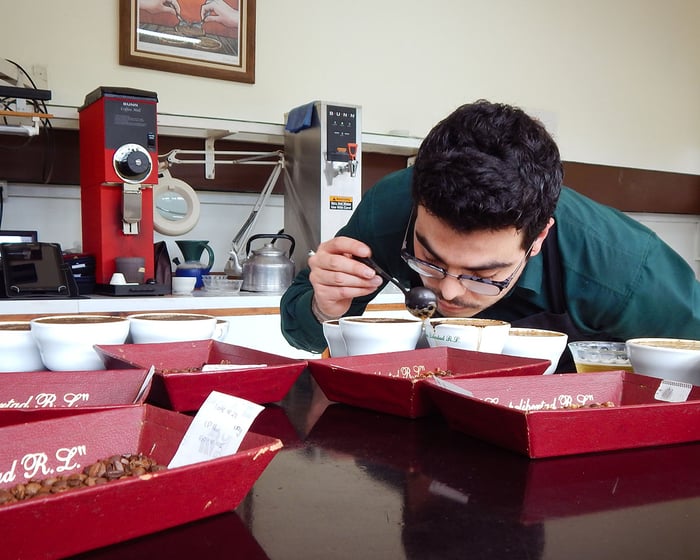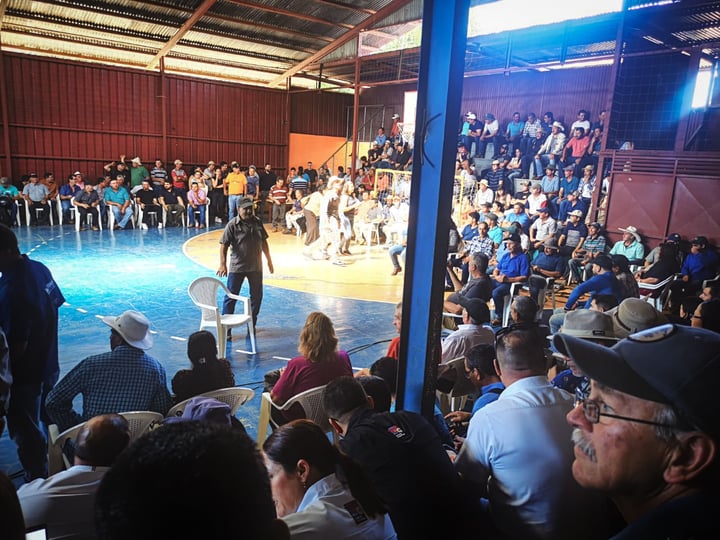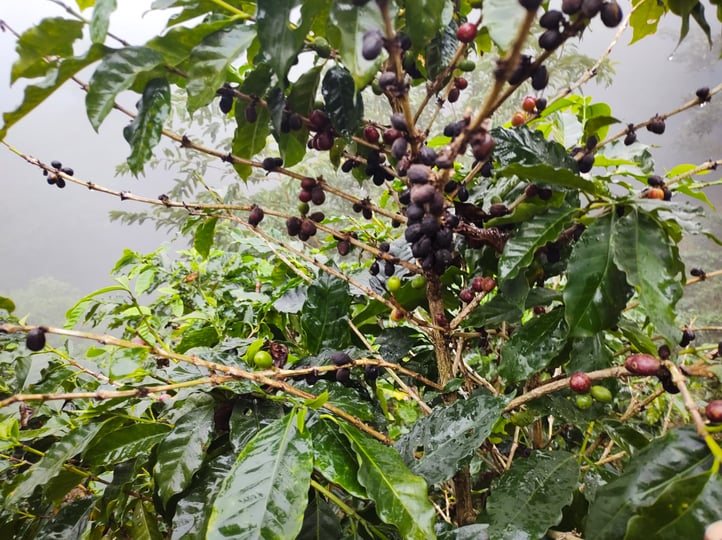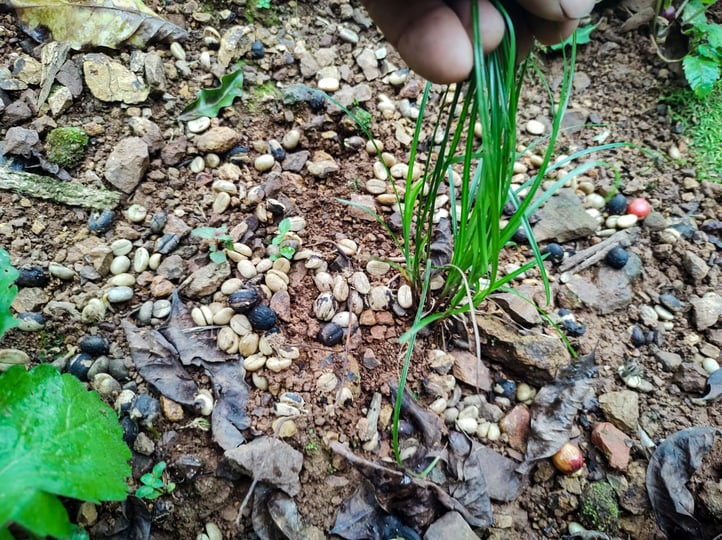- The price of Costa Rican coffee went down due to market pressures (see it here). There is a good range of volume lots available for shared or custom shipments. Orders are open until May for August-September delivery.
- The colón’s value against the US dollar grew 25% in 2023. For every dollar buyers pay, producers are making less money than one year ago.
- ICAFÉ estimates that the 2023-24 harvest will produce 12.6% less coffee. Local producers believe this is undervalued and should be corrected to around 20% less.
- With less coffee to sell and a stronger currency, producers are struggling to pay their debts. A new fund was approved in January to refinance loans taken last season.
- The country’s low output is a result of irregular rains and labour shortages. Coffee cherry maturation was uneven, resulting in volume losses. Nicaraguan workers are becoming rarer and Panamanians didn’t travel to protest against a mining company.
- A global leader in forest conservation, Costa Rica is one of the best-prepared countries to comply with the EUDR. Producers hope environmental awareness leads to more perceived value.
Coffee producers in Costa Rica are earning less per kilo of green coffee sold this harvest. This is the case for both commodity and specialty coffees, even when buyers maintain the FOB prices paid last year.
It doesn't mean that these coffees are more expensive. Volume lots are cheaper. It's the case of Don Claudio FW and Matinilla Fancy, for example. Producers can't escape the pressure exerted by prices set at the Intercontinental Exchange for commodity coffee.
The c-price pressure would be less of a problem if producers were not facing other challenges. But their earnings in the 2024 coffee harvest are being wiped by a strong colón and a smaller harvest.
This is affecting producers' ability to repay debts and frustrating the government’s efforts to improve working conditions and fight labour shortages in rural areas.
This blog is a deep dive into the economics of Costa Rica's coffee in 2024. A range of lots from co-operatives and farms is live on the marketplace. Shared shipments close in May for August-September delivery.
>> Costa Rica on algrano.com. All coffees created and priced by producers.
The Colón’s Appreciation
The colón appreciated against the US dollar at a 25% rate in 2023, when commodity prices dipped, and differentials for Other Milds shrank.
The appreciation is a result of the government’s strategy to reduce external debt, implemented by the new president, Rodrigo Chaves, elected in 2022.
Despite better living conditions and social security than its neighbours, Costa Rica had been struggling with poor economic indicators, such as an increase in the number of people living in poverty, a high rate of unemployment, and the largest public debt in Central America.
The economic policies brought an influx of foreign investment to the country and led to a resurgence of the tourism sector.
 Gerardo Arias Camacho was involved in discussions to refinance loans (Photo: Café Directo)
Gerardo Arias Camacho was involved in discussions to refinance loans (Photo: Café Directo)
Coffee producers like Gerardo Arias Camacho of Café Directo in Tarrazú appreciate that the economy has improved. But they can’t ignore the consequences to exporting sectors. In Costa Rica, 90% of all the coffee produced is exported.
“The country’s economy is better, and there is an effort to take Costa Rica out of its financial hole. It’s a good thing but it affects exporters,” says Gerardo. “But it’s hard to explain to customers that I am making less money even if they pay the same price as last year.”
The farmer says most of his customers kept stable prices paid for specialty coffee. However, he is constantly asked why his micro-lots are “expensive” when prices at the Exchange went down.
Even at the same prices, Gerardo is now getting between 20% and 25% less money from specialty coffee than in the previous two years.
The Struggle to Make Debt Repayments
The loss of earnings is also affecting producers’ liquidity. Guillermo Trejos of Cooplibertad in Central Valley explains that, while production costs remain high, Costa Rican producers have less coffee to sell.
He believes that the announcement by ICAFÉ (Instituto del Café de Costa Rica) - that the 2023-24 crop is 12.6% smaller - is an underestimate and “it will probably be corrected to around 20%”.
Guillermo also estimates that Coopelibertad will have 10% less volume of specialty coffee this year because of weather events.

Guillermo Trejos believes the country has the potential to further improve the working conditions of pickers - but it might not be enough (Photo: Coopelibertad)
Guillermo was quick to dismiss the news that the Intercontinental Exchange is adjusting differentials for Costa Rican coffees, adding a premium of 10 cents per pound. He sees a downward trend for Central American diffs.
“Costa Rican coffee used to be sold at +80. That has been reduced to +50. The 10 cents premium won’t have any impact on trade here.”
 Farmers filled a local school gymnasium to discuss a debt financing package (Photo: Café Directo)
Farmers filled a local school gymnasium to discuss a debt financing package (Photo: Café Directo)
In January, 500 coffee producers of Los Santos Zone, which includes Tarrazú, met with representatives of the Department of Agriculture and ICAFÉ to discuss a debt repayment support package. Gerardo was one of the people who gathered at the gymnasium of a local school to put the case forward.
Producers in Costa Rica accumulated large amounts of debt in the last couple of years when the price of fertilisers skyrocketed.
 Meeting between Los Santos' farmers and the government in January (Photo: Café Directo)
Meeting between Los Santos' farmers and the government in January (Photo: Café Directo)
Gerardo said large exporters, many of whom are the local branches of well-known multinational importers, encouraged farmers to buy inputs with the promise that prices would remain high, which they did not.
Farmers’ loans usually start being repaid in March, when new credit lines are opened to buy fertilisers for the next harvest. But with lower production and a weaker dollar, producers are struggling to meet their debts.
Since the January consultation, the government has approved a fund of ₡5.000 million to support the coffee sector. Cheaper loans will be provided to refinance farmers’ debts, giving them more time to make repayments.
Work Conditions and Labour Shortages
The government has recently introduced a new work accident insurance policy for coffee pickers. This is part of a wider strategy to improve working conditions in coffee farms and fight the labour shortages faced by producers in Costa Rica. The insurance will be paid by farmers and ICAFÉ.
This season’s shortage has been especially severe. Migrant workers, largely indigenous peoples from Panama and Nicaragua, represent more than 75% of seasonal workers in the country.
While Nicaragua is seeing a migration wave to the United States, many Panamanian workers didn’t travel this season to join protests against a Canadian mining company, First Quantum.
Panamanians opposed the expansion of the Cobre Panama site, concerned about the environmental impact of copper mining in the rainforest, and the disturbance of indigenous lands. Protests included roadblocks, further complicating workers’ access to Costa Rica.
Irregular Rains and Ripening
This year’s lower production in Costa Rica is directly linked to weather events.
In the first months of 2023, irregular rains led to an early and staged flowering season. The harvest started over a month earlier than usual and coffee trees didn’t reach ripening at the same time.
Uneven ripening slows pickers, typically paid by kilo of coffee cherry. This makes picking less attractive because workers make less money per day, disincentivising people to travel to coffee farms during the season.

Cherries were left unpicked on coffee trees due to labour shortages (Photo: Café Directo)
Gerardo of Café Directo says that climate change is affecting the rain regimen to such an extent that a farm in Tarrazú, famous among workers for even ripening and good earning prospects, can now have up to six flowerings. In the past, there used to be only two.
The combination of weather and labour shortages is having a huge impact on Costa Rica’s productivity. Without pickers, farms were exposed to rain during the harvest - also unusual for the country. Cherries dropped on the ground, where they fermented, or absorbed too much water and cracked.

As the harvest progressed, the floor was covered by fallen coffee (Photo: Café Directo)
Fallen cherries could be sold in the domestic market as low-grade coffee. But without enough workers, the coffee that fell was lost.
While the work accident insurance was well received by producers, they believe it’s not sufficient to solve their current challenges.
Gerardo is seeing more inexperienced pickers come to the fields. “You can have many people working and still get to the end of the day without that much coffee,” he says.

Workers wouldn't pick fallen cherries, leaving them to dry on the floor (Photo: Café Directo)
Guillermo of Coopelibertad agrees. The cooperative saw a smaller workforce than expected this harvest. “Farms have suitable conditions to adapt structures for housing. There are sustainability projects to fund community shelters for pickers. Efforts are being made, and they are positive. But it’s not enough.”
Your Coffee Dollar is Still Worth a Lot
While producers fight for insurance against harvest losses caused by weather events, something that already exists in Brazil, they also have hopes for their international buyers.
The EUDR is making buyers consider deforestation and labour rights whether they like it or not, and Costa Rican coffee is a safe supply chain.
The country’s environmental and labour laws are already among the strictest in Central America. According to Gerardo, farmers pay workers 40% more than their base wage in the form of social security, something that doesn’t exist in Honduras or Guatemala, for example.
 Costa Rica is famous for its reforestation efforts and environmental policies (Photo: Café Directo)
Costa Rica is famous for its reforestation efforts and environmental policies (Photo: Café Directo)
Costa Rica is a global leader in forest conservation and the first tropical country to have reversed deforestation. Its forest cover went from 40% in 1987 to nearly 60% in 2019.
The country also pioneered the sale of certified carbon offsets to provide funds for reforestation and forest protection on private lands.
Today, they are ahead of most countries in mapping and monitoring farms, easily done on a phone app developed by ICAFÉ and downloaded by farmers.
The country also imposes hefty fines on those who cut trees. “We have a culture of forest protection. If you cut a tree, you're reported by your neighbour. The police comes. You pay a lot of money,” Gerardo explains.
>> Costa Rica on algrano.com. All coffees created and priced by producers.




Let Us Know What You Thought about this Post.
Put your Comment Below.